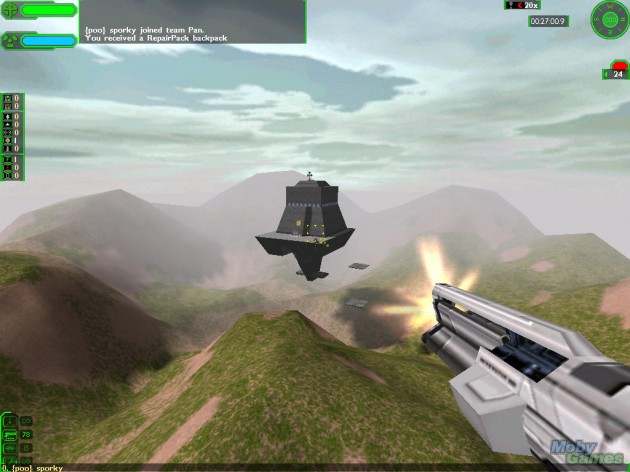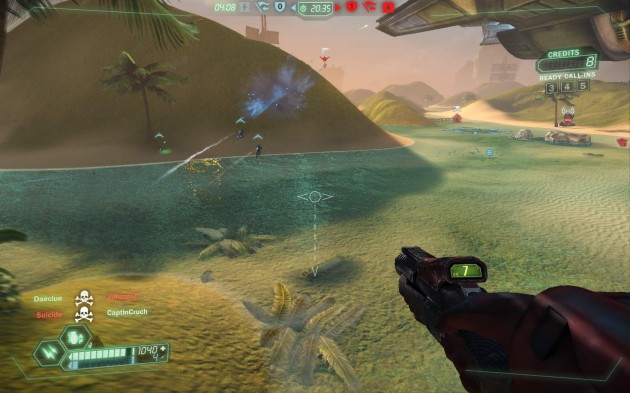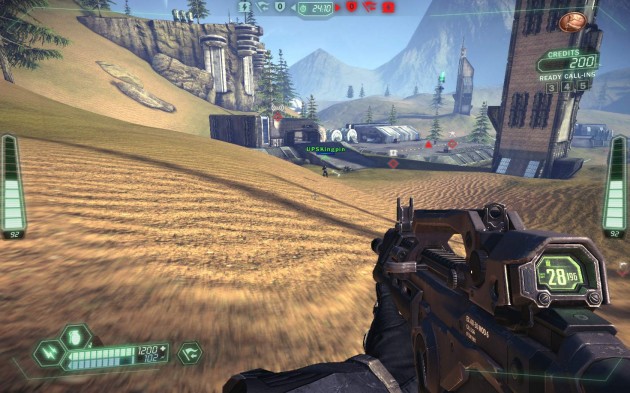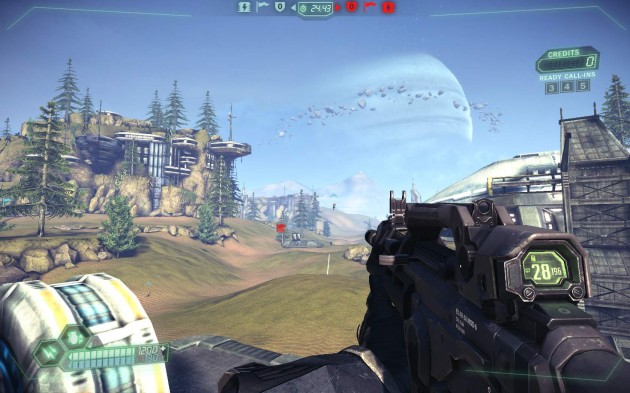“Bloody hell that’s fast!” my friend Andy exclaimed as he caught a glimpse of me playing Tribes: Ascend. I had decided to take a quick break from the frantic shenanigans of Icrontic’s yearly St. Patrick’s Day community event to play a few rounds of Tribes, and Andy’s astute reaction was one of many from curious onlookers as I skied across the slopes of alien worlds. Tribes: Ascend, a free-to-play FPS by Hi-Rez Studios, is defined by the first thing that people notice when they see it in action—raw speed. This is the Bugatti Veyron of shooters.
Tribes: Ascend is a revitalization of an absolute classic. The original Starsiege: Tribes game was released in 1998, and it introduced almost every single feature found standard in FPSes today. The game was exclusively multiplayer and offered 40 massive open maps, jetpacks, 32-player games, multiple player classes, three different armor weight classes, vehicles, custom mod/skin/script support—the list goes on and on, and the gameplay was unlike anything else on the PC at the time.
A hail of gunfire and a trip down the slopes
A typical run in Starsiege: Tribes would involve grabbing a weapon loadout, flying via jetpack to breakneck speeds—then ascending 100 feet, firing explosives from the apex of your flight, landing in a tank with another teammate, driving to the enemy’s flag tower, blasting turrets and radars with the main cannon, jumping out and nabbing the flag, then flying back to your base while skiing up and over the hills in between avoiding laser blasts and explosions from the enemies flying all around you, to finally cap in a hail of gunfire and chaos. All of this, 14 years ago. It’s hard to imagine all of these features in one game when modern games hardly feature a fraction of them.
A defining feature of Starsiege: Tribes was something that wasn’t meant to be a feature at all. Early on in the game’s life, players discovered an exploit of sorts with the game’s physics engine. While jetpacking over a hill, well-timed taping of the jump button as you slid down a slope allowed you to gain momentum. By chaining together jetpack flights and downward slides, players could gain immense speed and blast across the map on flag runs at a fraction of the time of what was previously possible. This technique, known as skiing, became an essential component of mastering the game.
In 2001, a sequel was released. Tribes 2 improved on almost everything from Starsiege: Tribes, all the while making skiing an actual feature. Since then, however, the Tribes series has fallen mostly silent. A third game of sorts was released in 2004, but most real fans refuse to acknowledge the title thanks to its many problems and new development team. That is why now, in 2012, it is an absolute treat to not only have Hi-Rez studios working on a new Tribes game, but also that the game is a complete celebration of the original series by refusing to make a game that appeals to modern audiences.
Gotta go fast
Tribes: Ascend does not conform. It is a proper PC shooter. It still has jetpacks, it still has three armor classes, it still has vehicles, and it still has shazbot. It does everything the original game did and more. And the speed. Good Lord, the speed.
Tribes: Ascend is so fast it’s stupid. This game dances circles around Quake 3 and Unreal Tournament. Once again, skiing is an implemented component of gameplay, and if you can’t go fast, you won’t win. Modern skiing in Tribes: Ascend works like this: when the space bar is held down, your character goes into a floaty, zero friction mode. Any speed you had will not reduce until you hit an upward slope. Furthermore, a speed bar is displayed that shows your speed in km/h. This gives you data on how quick you’re moving, and helps you make calls on whether or not you’re moving fast enough to make a flag capture. The skiing concept may seem difficult on paper, but this video is a good showcase of what a typical flag run looks like:
Flag capturing is complicated in the Tribes universe. Unlike every other CTF game out there today, it is seriously frowned upon to attempt to grab the enemy flag on foot and without going fast. In fact, simply running up to the flag and grabbing it is known as a “llama grab”, and it even earns you an achievement badge declaring your efforts as such. The reason why llama grabs become problematic is because the grabber, without speed, is very likely to be killed quickly by the enemy. Real flag runners will orchestrate long, map-wide ski routes to build up insane speed, then blast across that flag stand at 200km/h+ to snatch up the flag and be well on their way home before the enemy has a chance to react. A light-armored speedster can become nearly impossible to catch if a proper grab is executed.
Besides skiing, one of the defining components of the Tribes games is the base defenses and generator. All of the stationary turrets and sensors are powered by a centrally located generator. The turrets dish out heavy damage, and the sensors help you to see nearby enemies around your base. If an enemy manages to push into your base and destroy your generator, all of those defenses go offline, crippling the base. Until the generator is repaired by a player, the base is fully vulnerable. Strategies become split between generator defense and flag defense, while having players to on flag runs. A healthy generator is just as important as a protected flag.
Though Capture the Flag is the game’s most popular game mode, Tribes: Ascend does offer a slew of other modes. There’s a Team Deathmatch mode that functions as you’d expect, but with a twist. A flag is present on the battlefield, and the flag holder earns points for their team as long as they hold it. So the game becomes a frantic cat and mouse situation, with hordes of players skiing all over the map in pursuit of the flag holder. It’s extremely chaotic and fast. Tribes: Ascend also has an Arena mode, which features Quake 3-style maps and plays like a more traditional team deathmatch. Arena has a limited number of respawns for each team, and once the counter hits zero, players stop respawning unil the entire team is destroyed.
There are nine classes to choose from, and three classes per armor weight. So there are three light classes, three mediums, and three heavies. Each class has its own weapons and abilities that can be upgraded or swapped out with unlockables. To upgrade, in a method similar to other free-to-play titles, players can spend accumulated XP or take the short route by turning real money into gold. Each class offers a primary and secondary weapon, both with unlockable alternates. There is quite a bit of customization in the unlocks and upgrades system, allowing each player to set up their favorite classes to match their play style. Fortunately, with the ability to buy the secondary items, gold users don’t seem to have a distinct advantage over those who choose to unlock with experience.
The weapons of Tribes: Ascend require a fair amount of skill to use. Most of the weapons are projectile-based, meaning there is a travel time to the fired munitions. So considering that two combatants are flying at each other at various altitudes and at various speeds, players have to lead their targets considerably. The few automatic weapons make this simple enough, but many of the weapons are slow-firing explosive launchers, such as the classic disk launcher made famous in the original game. Nailing a flying player with a direct hit from a disk will earn you lots of points, though, and skilled players dish them out regularly. Few things feel more satisfying.
Over and out good buddy
Much like the original two games, Tribes: Ascend has a full voice command system that allows you to announce, respond, request, and taunt rapidly without distracting you from the game. The command menu is intuitive—pressing V activates voice, then the player selects a category, then the command. Each voice command is only 3 to 4 letters long, and the commands are displayed in chat for quick reference. For instance, pressing [VSAF] shouts “I’ll go for the enemy flag”, V signifying voice, S signifying on self, A signifying attack, and F signifying flag. [VWV] shouts “Incoming Enemy Vehicle” signifying Voice/Warning/Vehicle. [VGS] shouts Shazbot with Voice/Global/Shazbot. It seems archaic, but the system works better in Tribes than any other game I’ve ever played with them. Plus, it makes for some funny moments.
Unreal Engine ahoy
Graphically, Tribes: Ascend is not only one of the best looking free-to-play games out there, but it’s one of the prettiest PC shooters available. Powered by the tried and true Unreal Engine 3, the game has some gorgeous lighting effects and motion blur (which will really blow your mind when going fast). The world of Starsiege is beautifully rendered in Tribes: Ascend, as each map showcases giant ships flying overhead, casting shadows onto the world below. Massive planets and moons dot the skyline, and weather effects such as snowstorms and tornadoes accent the themes of each map. Most impressive to me is the per pixel shadowing on the weapons held in your hand. As you turn toward the sun, shadows dance across every crevice and contour of the gun. It’s an effect more complicated than what was achieved in Crysis. Not bad for the old UE3 engine.
A nice, unexpected touch is the in-game music that’s played on each map. Music is rarely found in multiplayer shooters, and you quickly realize after a few rounds of Tribes just how much it adds to the experience. Big, orchestrated numbers accent the massive struggle unfurling on the battlefield. When you grab the flag, the music immediately changes to an uptempo number that makes the process feel even more frantic. It reminds you what is at stake, and it makes you want to move even faster. The music works in every scenario, and it is a wonderful touch to an already gorgeous game.
DAT GAME
So Tribes: Ascend is a lot of fun, totally unique, and satisfyingly complex, but that’s not why I love it. The game is currently in open beta, preparing to launch next month. As a result, Tribes: Ascend enjoys a very unique, tight-knit and humorous community. The developers regularly interact with the fans via Reddit, 4Chan, Facebook and such. There is tons of fan generated content. Skill videos and instructional tutorials populate YouTube, followed by lots of funny videos showcasing glitch shenanigans and silly plays. The community is extremely enthusiastic about the game and what Hi-Rez are doing with it. I haven’t had this much fun with a community since the very beginning days of Team Fortress 2.
Hi-Rez Studio’s closeness to the community is what really makes the game special. The Tribes community have adopted “GOTTA GO FAST!” as a tagline of sorts for the game. The association with the meme is obvious, with 4Chan having spread the phrase around initially. Hi-Rez took note of this, and they put an achievement badge in the game titled “GOTTA GO FAST” that is awarded to players whom achieve extremely high speeds. If you type GOTTAGOFAST into the secret code area, every mention of km/h in the game is replaced with “SANICS”. Rumor has it that Hi-Rez may be adding Nyan-cat type trails to players who reach the break-neck speed of 300km/h or higher. Even the Tribes: Ascend release trailer, which showcases the tragic life of a llama grabber while spoofing Dead Island, shouts out to the fans with in-joke references in the video info and tags:
Tribes: Ascend is already a great game, and Hi-Rez Studios have a lot in store for their beloved community. You can get the game now at the Tribes: Ascend website. Get in on the game early and experience one of the finest examples of PC gaming in a long while. Just be sure to check your slow at the door—you gotta go fast.




































 Articles RSS
Articles RSS